
20 Years of Military Flight Simulations, 1980-2000
The New Millenium
B-17 Flying Fortress 2
Early in 2001 Microprose passed into history, purchased by Hasbro Interactive and then dismantled. Hasbro Interactive, meanwhile, released Wayward Design’s B-17 Flying Fortress: The Mighty Eighth, a simulation destined for classic status. B17 emphasized the aircrew experience, with the ability to man any position in the Flying Fortress.
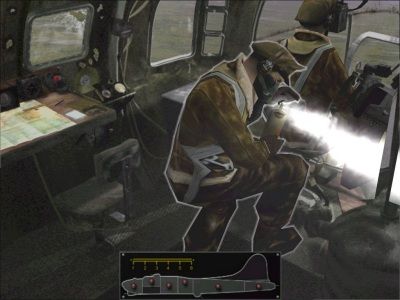
B-17 II Nose Crew
Featuring state-of-the-art graphics, detailed crew animations and a full 3d environment, B-17 Flying Fortress: The Mighty Eighth blends the action and role playing genres. B-17 Flying Fortress: The Mighty Eighth features a dynamic campaign system, but its release was marred by the exclusion of key features, like multiplayer support and detailed engine management. The engine management issue was later addressed in a patch.
Battle of Britain
Simultaneously, Rowan finished their Battle of Britain, a sweeping simulation of the air battle over England that integrates a strategic game, played from a simulated wartime Operations Room. Battle of Britain offers huge aerial battles (up to 1000 aircraft in the skies), a fully dynamic campaign system, top notch flight models and the ability to influence the course of history.
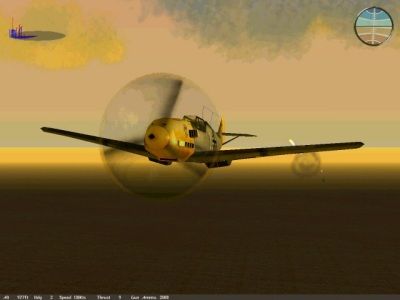
Battle of Britain
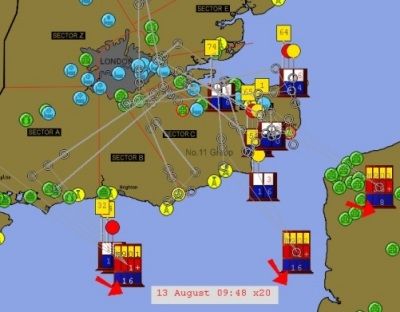
Battle of Britain
With niggling hardware compatibility issues, but garnering a dedicated following, a lively community has evolved around both these simulations. Both have spawned many user created skins, and Battle of Britain in particular has an active community of aircraft painters and terrain designers.
Eurofighter Typhoon
As the year progressed Infogrames released Eurofighter Typhoon possibly the last in a long line of simulation classics from the Digital Image Design stable.
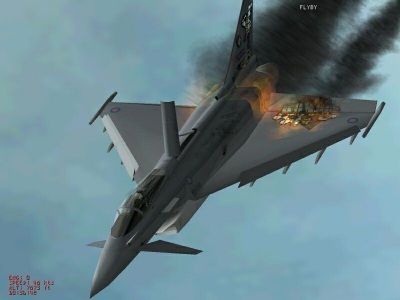
Eurofighter Typhoon is a great looking simulation of the Eurofighter Typhoonaircraft, and the game, like the earlier version EF 2000, is set back in the fjords of Iceland in 2015. Russia has invaded Latvia and Lithuania, NATO protests and the war escalates in Europe. Iceland is of vital strategic importance for resupply of Europe and Russia sets out to capture the island.
With Eurofighter Typhoon Digital Image Design took their real time dynamic campaign system and their WARGEN campaign AI and notched up the realism to include dynamic resource management. Furthermore, the campaign runs in real time whether the player participates or not.
In fact, Eurofighter Typhoon has only one mode: the campaign mode. There are no single or quick missions and there is no mission builder. The single mode approach works fairly well, with the player tracking six pilots through the campaign. The life and death of these pilots determines the player’s success in the conflict.
Online gaming takes off
In June Strategic Simulations Inc released a free upgrade to Su-27 Flanker 2.0 in version 2.5, adding numerous features and improving gameplay. The list of features includes the ability to fly the MiG-29K (navalized version), the ability to set waypoints for ships and ship to ship engagements, IFR (in flight refueling), and an improved view system.
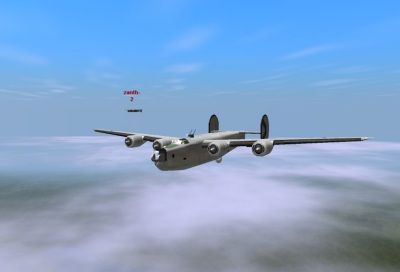
A B-24 Liberator with escort in Warbirds III
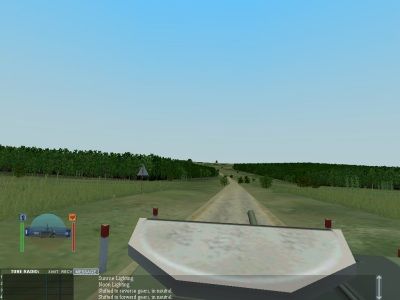
Furthermore, version 2.5 improves multiplayer chat, expands wingman control, expands graphics support for 3d hardware, and adds new scenarios and a new campaign.
2001 has seen increased online action, with WarBirds III and WW2 Online going beta. WarBirds boasts a long history and a loyal following, and has finally arrived in the modern world graphically.
More than merely better looking, however, WarBirds III adds new aircraft, a new strategic dimension, ground vehicles, artillery, offline combat and support for force feedback. Furthermore, damage modeling and damage resolution has improved considerably since version 2.5.
Like the other MMOG flight simulations, the player can choose a variety of arenas including relaxed realism. Special events are scheduled regularly, like the upcoming Battle of Britain and Operation Sea Lion. A new flat rate pricing structure should also encourage new adherents.
IL-2 Sturmovik
Meanwhile Falcon 4.0 continues to grow. Not long after the demise of Microprose the iBeta team announced that they would continue to patch Falcon 4.0, and they released a series of patches improving multiplayer code, fixing bugs, and adding features. At the same time a separate group based around eRazor formed to build realism patches and add new features. The latter group (now known as eFalcon) recently released patch 1.09, adding the updated systems technology of the F16 MLU to Falcon 4.0.
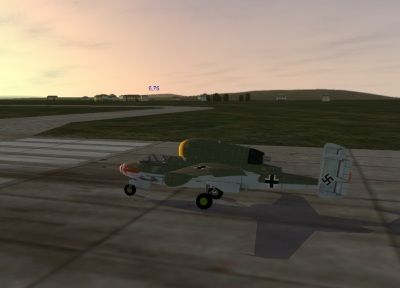
IL-2 Sturmovik
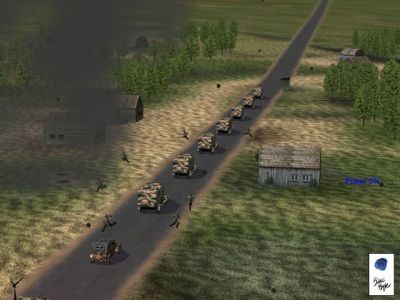
IL-2 Sturmovik
In November, 2001, Blue Byte released IL-2 Sturmovik, a simulation of the neglected Eastern Front of WWII. Many of the simulated aircraft have never before been seen in a combat flight simulation. With some thirty flyable aircraft, Maddox Games have set their sights on realism, taking into account every aspect of physics in their flight and environment model
In fact, the bar is being raised so high with IL-2 Sturmovik that it will set the standard for years to come. Aircraft and the environment are stunning; cockpits, damage and physics models are beyond anything seen to date. IL-2 Sturmovik supports multiplayer coop missions with up to 32 players, in addition to AI controlled aircraft. The IL-2 engine is likely to be used for a MMOG, and perhaps a second simulation set in WWII Europe.
Thrustmaster HOTAS Cougar
Finally, as 2001 closes the community anticiates the release of Thrustmaster's latest hardware, the HOTAS Cougar. This new gear brings the earlier F22 Pro and TQS up to military standards, with all metal construction and new high performance parts. Connectivity moves to USB, onboard processing is included, and the earlier track ball is replaced by an actual microstick.
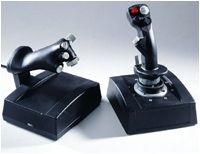
Thrustmaster HOTAS Cougar
Furthermore, the system is designed for easy expansion, with a removable handle. This will allow the development of new handles to represent various modern or classic aircraft grips. Maintaining the highest degree of programmability and with all new software developed by James Hallows, the HOTAS Cougar is likely to see the desktop of most serious combat simulation pilots worldwide. The later release of matching rudder pedals is almost certain.
GeForce 3 GPU
Other hardware developments in 2001 included the release of Nvidia’s Hercules 3D Prophet III Titanium 500 and Videologic’s KYRO II chip.
This new chip uses a new approach to rendering images. Rather than using a larger hammer, Imagination Technologies uses a sharper nail. By working smarter with new technology, they get away with greater simplicity, translating into a lower retail price.
KYRO II boards come with either 32 or 64MB of slower, less expensive SDRAM. Although this means less memory bandwidth, the streamlined rendering process requires much less bandwidth. In short, the hardware tests whether or not a polygon is rendered before it is actually drawn. This method saves the hardware from having to draw and output polys to the screen that will end up being hidden by other objects anyway. The increase in rendering efficiency is as high as 300%.
The weakness of the KYRO II generation is that it is DirectX 8 compatible, but not compliant, as the Hercules 3D Prophet III Titanium 500is, limiting future growth. But as a competitor for Nvidia’s GeForce 2 GPU, the new chip is an excellent solution.
The theoretical fill rate of Hercules 3D Prophet III Titanium 500 is lower than GeForce 2, but in practice is more than 40% higher. In Quake II HQ at 1024x768 and 32 bit color on a 1GHz Pentium III system, Hercules 3D Prophet III Titanium 500 is 20% faster than GF2. In current games the difference isn’t always noticeable.
Hercules 3D Prophet III Titanium 500 supports a wide range of new features available in the latest DirectX 8 API. Not only does it sport the same integrated 'static' transform and lighting engine as GF2, but adds a programmable vertex processor and programmable texture operations. As a result, game developers are able to include new effects previously seen only in movies. Some of these effects are nothing short of spectacular.
While this makes little difference with current titles eventually, in games where DirectX 8 features are fully exploited, games will run up to 60% faster, and with effects never seen before.
LOMAC
to create an entirely new product with expanded air and ground action in a completely new campaign environment. LOMAC will allow players to fly a variety of US and Russian combat aircraft in a dynamic and unpredictable combat environment.
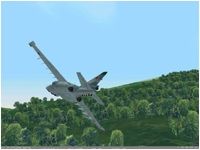
Low to the Treeline in LOMAC
Eight flyable aircraft are planned: the F15-C and A10 for the US, and the standard and naval Flanker, the standard and naval MiG 29, the Su25 Frogfoot and the Su39 naval version.
LOMAC takes air combat action and blends it seamlessly with a dynamic ground war. It offers the player air to ground action for either the US or Russia. An expanded theatre of operations is featured, and graphics are greatly improved down low, as befits a ground war expansion.
2002 will also see the release of CFS III, possibly set in Europe. With the purchase of the Falcon 4.0 licence by G2 Interactive, Falcon V will likely see release in the summer of 2002. Other projects in development include Target for Tonight, Wings with Wires, Project 1 and Target Korea.
The future?
From 1981-2001 we have twenty-one years of combat simulations on the PC. What will the next ten years bring?
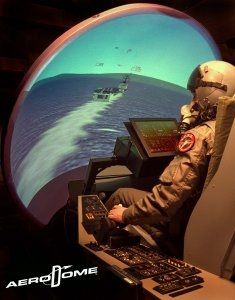
The AeroDome at FlyAces
Imagine a 10 GHz CPU with 2 GB of main memory, running a fifth generation GPU. Most of us will find this difficult to imagine!
Now imagine a multiprocessor machine with four of these CPUs onboard.
Further imagine optical connections direct to your computer. Imagine 50 times the bandwidth of cable coming directly into your home.
As for display technology, imagine a 40 inch curved screen designed to enhance peripheral vision. (Perhaps the ACES AeroDome will be enhanced and mass produced - see http://www.flyaces.com.
Imagine running this LCD device at 2048 x 1536 on a video accelerator with 512MB of memory.
The Internet will continue to grow in importance and will impact the quality, style, and distribution of military simulations. Games which create community will become more important than games which encourage an isolated experience.
A final word.
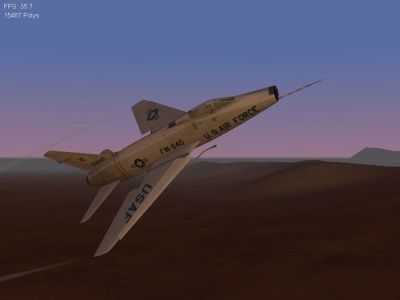
F-100D Super Sabre in Project 1
The quality of the simulation experience has been shaped by the marriage of hardware and software, and technologies now in their infancy will soon have greater impact. These include force feedback technology as well as VR headsets and multiple sound sources and channels.
With regard to features, we are already seeing the inclusion of individual trees and infantry on the ground (both IL-2 Sturmovik and WarBirds III), and this trend will continue.
IL-2 Sturmovik pushes the bar beyond anything seen to date in terrain and ground object detail, as well as ground activity, but as CPU and GPU horsepower increase, the levels of detail will also increase.
Currently the number of combat flight simulations in development is relatively small, but production is cyclical, and the fan base continues to grow. Military flight simulations will always be around, and some of the personalities who have moved on to other areas will surprise us with new entries. These developers are generally devoted to military history and gaming, and the fascination endures.
Let the bard have the final word:
Leonard Hjalmarson.
